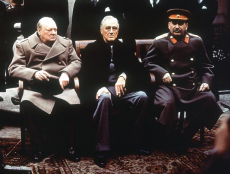
Perceptions were vital to the origins of the Cold War and are not given enough consideration by many authors. Gaddis identifies that the US did not want a Cold War, but feared insecurity and Communism more. Therefore, a combination of misunderstanding their Eastern rival and a fear of what they did not understand placed increasing pressure on the US to appear more hardline against Communism. The USSR made the claim that as they had suffered greater losses than all other nations combined in both World Wars they now wished to secure a ‘buffer zone’ of countries surrounding Russia under their control as a security measure. This seemed perfectly reasonable and the USSR did indeed take control of Poland, Bulgaria, Austria, Czechoslovakia and many other nations in Eastern Europe surrounding Russia without impeding on the US’ accepted zone of control. However the action appeared aggressive to the US because it had been instilled in them that Communism was a great unknown evil that would spread across the world. In actual fact Stalin had asked Churchill and Roosevelt in 1942, some thee years earlier, if the USSR could be entitled to these nations after the war, particularly as they had been claimed by Stalin in the Nazi-Soviet pact of 1939 and Roosevelt delayed an answer till post war but ultimately died in 1945. Therefore, although we cannot assume that Stalin had no interest in expansion, the fact is that the US viewed every Soviet action through their rose tinted view of Communism. We must bear in mind that we have the benefit of hindsight but in 1945 all the US government saw was a rival to their power with a polar opposite ideology rapidly expanding their territorial gain across a damaged and defenseless post war Europe.
Furthermore, a civil war was raging in China and the Communists seemed to be gaining the upper hand, and also the US had just emerged from World War II so the legacy of the 1938 Munich Agreement and the power of Nazi Germany was fresh in their minds; so to the US aggression could not be appeased, it had to be confronted. This paper does not intend to justify either US or USSR actions, only to note that they perhaps misunderstood one another’s intentions. Ultimately Washington’s hand was forced largely by the people also. Having just defeated one tyrant people feared that Stalin was simply replacing Hitler and this placed even greater pressure on the US’ shoulders to act. The US had been very isolationist in the past and the people wanted a return to these ways. However Communism was seen as a threat that could not go unchecked so they faced a paradox. Although the Government held out for several months there was a great increase in anti-communist thought and propaganda following Churchill’s Iron Curtain speech and it was in the general interest of the US politicians to appear hardline against what were considered to be foreign dangers. As Crockatt notes, political caution and an open world order were the original themes dominating US foreign policy in Europe in 1945 and it was not until 1947 when it became clear that there was a necessary divide between the two superpowers that the Marshall Plan and Truman doctrine were instigated.Indeed Truman restrained from using the argument of ideology and stark differentiations between the US and USSR until March 1947 when the US gave aid to Greece and Turkey against Communist insurgencies. In his speech he describes two separate ‘ways of life’, clearly distinguishing the ‘freedom’ of democracy against the terror of Communism forced upon peoples who needed liberating. Although we are forced to consider mainly from the US perspective, much the same could be applied to the USSR, these two superpowers did not understand one another, and when we do not understand we can become defensive and fearful, and that is precisely why false perceptions contributed so greatly to the origins of the Cold War.

0 Comment:
Be the first one to comment on this article.